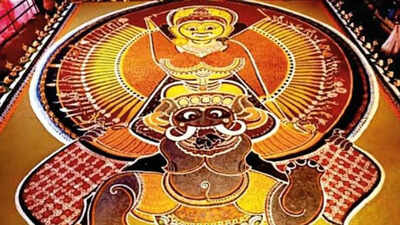Goddess in pigments: The transient masterpieces | Kochi News

As 88-year-old Sankara Kurup begins the sacred Vadakkupurathu Paattu at Vaikom Mahadeva temple on April 2, 2025, gently laying down white rice powder to outline Goddess Bhadrakali on the floors of a specially made mandapam, it will be his fifth time leading this 12-day ritual, a tradition observed only once every 12 years.
Vadakkupurathu Paattu weaves together the visual splendor of Kalamezhuthu, the intricate floor painting with coloured powders and the melody of Kalam Paattu, devotional songs that praise Goddess Bhadrakali.
What begins as a simple outline gradually evolves into a stunning visual narrative, with Kurup meticulously using only five natural pigments: Green from Vaaka leaves, black from burnt husk, red from lime and turmeric, white from rice powder, and yellow from turmeric. Over the first four days, the Goddess’s eight-armed image takes shape across a vast 1,400-square-foot area.
As the days progress, the number of hands increases proportionally, culminating in a majestic portrayal with 64 hands and her divine vehicle, the Vethaalam. On the final day, the sheer scale of the painting requires an astonishing 490kg of powdered pigments. As Kurup begins the first day’s drawing, he is assisted by a team of 20 artists. This number gradually swells, reaching 60 on the final day, each artist contributing to the grand tableau.
Yet, this splendor is transient. Each day, after four to six hours of meticulous labour, the complet ed painting is ritually erased using tender arecanut inflorescence, its vibrant pigments distributed to devotees as sacred prasadam.
Sankara Kurup, a member of the Puthusseri Kurup family, which holds the family right to perform this sacred art. “I first attended Vadakkupurathu Paattu as an assistant to my uncle at the age of 28,” he said, reflecting on his lifelong connection with the ritual. The ritual art is not just a profound dialogue between the human and the divine, painted in ephemeral, vibrant strokes. It pulses with life through Kalam Paattu—traditional songs that narrate the Goddess’s beauty and power in classical ragas such as Nata, Sankarabharanam, Ananda Bhairavi, Kalyani, and Samanthamalahari.
Rajesh Raghava Kurup leads the music sessions alongside the renowned Sopanam singer Ambalapuzha Vijaya Kumar, their voices interweaving with the rhythmic beats of Idakka, Veekan Chenda, and Chengila.
The lyrics, drawn from Ghana Sangham, penned by Poonthanam Nambudiri, describe the beauty of the Goddess from head to toe. “Other traditional hymns dedicated to the Goddess are also sung with devotion,” said Raghava Kurup.
The origins of this ritual trace back to a time when the region of Vaikom was plagued by infectious diseases, claiming many lives. Seeking divine intervention, the people approached a revered seer, who meditated at the Kodungallur Devi Temple.
Pleased with his devotion, the Goddess appeared before him and instructed him to conduct Kalamezhuthu and Kalam Paattu for 12 days at the northern side of the Vaikom Mahadeva Temple.
Ever since, this sacred ritual has been performed every 12 years.






